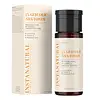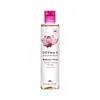What's inside
What's inside
 Key Ingredients
Key Ingredients

 Benefits
Benefits

 Concerns
Concerns

 Ingredients Side-by-side
Ingredients Side-by-side

Water
Skin ConditioningHamamelis Virginiana Flower Water
AstringentGlycolic Acid
BufferingArginine
MaskingGlycerin
HumectantLactic Acid
BufferingMalic Acid
BufferingGluconic Acid
Salicylic Acid
MaskingTartaric Acid
BufferingAscorbic Acid
AntioxidantTetrahexyldecyl Ascorbate
AntioxidantSodium Hyaluronate
HumectantLimnanthes Alba Seed Oil
Skin ConditioningGlucosyl Hesperidin
HumectantRosmarinus Officinalis Leaf Extract
AntimicrobialCentella Asiatica Extract
CleansingHibiscus Rosa-Sinensis Flower Extract
HumectantAllantoin
Skin ConditioningSalvia Officinalis Leaf Extract
CleansingCucumis Sativus Fruit Extract
EmollientGlycyrrhiza Glabra Root Extract
BleachingArnica Montana Flower Extract
MaskingCamellia Sinensis Leaf Extract
AntimicrobialMagnesium PCA
HumectantCopper PCA
HumectantZinc PCA
HumectantSorbic Acid
PreservativeRosa Canina Fruit Extract
AstringentCaprylic/Capric Triglyceride
MaskingLavandula Angustifolia Extract
Skin ConditioningPrunus Armeniaca Fruit Extract
Skin ConditioningRubus Idaeus Fruit Extract
AstringentGardenia Florida Flower Extract
Skin ConditioningAnanas Sativus Fruit Extract
Skin ConditioningVanilla Planifolia Fruit Extract
Skin ConditioningPyrus Malus Fruit Extract
Skin ConditioningCitrus Aurantium Bergamia Fruit Extract
Skin ConditioningCarthamus Tinctorius Seed Oil
MaskingPropanediol
SolventCitric Acid
BufferingCaprylhydroxamic Acid
Glyceryl Caprylate
EmollientPhenethyl Alcohol
MaskingPentylene Glycol
Skin ConditioningWater, Hamamelis Virginiana Flower Water, Glycolic Acid, Arginine, Glycerin, Lactic Acid, Malic Acid, Gluconic Acid, Salicylic Acid, Tartaric Acid, Ascorbic Acid, Tetrahexyldecyl Ascorbate, Sodium Hyaluronate, Limnanthes Alba Seed Oil, Glucosyl Hesperidin, Rosmarinus Officinalis Leaf Extract, Centella Asiatica Extract, Hibiscus Rosa-Sinensis Flower Extract, Allantoin, Salvia Officinalis Leaf Extract, Cucumis Sativus Fruit Extract, Glycyrrhiza Glabra Root Extract, Arnica Montana Flower Extract, Camellia Sinensis Leaf Extract, Magnesium PCA, Copper PCA, Zinc PCA, Sorbic Acid, Rosa Canina Fruit Extract, Caprylic/Capric Triglyceride, Lavandula Angustifolia Extract, Prunus Armeniaca Fruit Extract, Rubus Idaeus Fruit Extract, Gardenia Florida Flower Extract, Ananas Sativus Fruit Extract, Vanilla Planifolia Fruit Extract, Pyrus Malus Fruit Extract, Citrus Aurantium Bergamia Fruit Extract, Carthamus Tinctorius Seed Oil, Propanediol, Citric Acid, Caprylhydroxamic Acid, Glyceryl Caprylate, Phenethyl Alcohol, Pentylene Glycol
Water
Skin ConditioningGlycolic Acid
BufferingSodium Hyaluronate
HumectantPolysorbate 20
EmulsifyingSodium Hydroxide
BufferingPinus Pinaster Bark Extract
AntioxidantPanthenol
Skin ConditioningAspalathus Linearis Leaf Extract
Skin ConditioningRosa Canina Fruit Extract
AstringentSaccharide Isomerate
HumectantAloe Barbadensis Extract
Skin ConditioningAllantoin
Skin ConditioningChamomilla Recutita Flower Extract
MaskingCucumis Sativus Fruit Extract
EmollientPhenoxyethanol
PreservativeEthylhexylglycerin
Skin ConditioningParfum
MaskingWater, Glycolic Acid, Sodium Hyaluronate, Polysorbate 20, Sodium Hydroxide, Pinus Pinaster Bark Extract, Panthenol, Aspalathus Linearis Leaf Extract, Rosa Canina Fruit Extract, Saccharide Isomerate, Aloe Barbadensis Extract, Allantoin, Chamomilla Recutita Flower Extract, Cucumis Sativus Fruit Extract, Phenoxyethanol, Ethylhexylglycerin, Parfum
Ingredients Explained
These ingredients are found in both products.
Ingredients higher up in an ingredient list are typically present in a larger amount.
Allantoin is a soothing ingredient known for its protective and moisturizingg properties. Because of this, it is often added to products with strong active ingredients.
Studies show higher concentrations of this ingredient can promote wound healing.
Though it can be derived from the comfrey plant, allantoin is produced synthetically for cosmetic products to ensure purity.
Learn more about AllantoinThis extract comes from cucumber. Cucumbers are mostly made up of water (95%), and the other 5% is composed of: vitamin C, caffeic acid, fatty acids, amino acids, and other minerals.
Cucumbers have anti-inflammatory, barrier repair, and hydrating properties.
They contain shikimate dehydrigenase, an enzyme shown to help reduce inflammation and soothe the skin.
The amino acids found in cucumbers help nourish our skin's natural acid mantle (it's an important part of our skin barrier). This slightly acidic film acts as a barrier to protect us from bacteria, viruses, and other contaminants.
Unless you have an allergy to cucumbers, this is generally a non-irritating ingredient.
Fun fact: Cucumis Sativus is native to South Asia and can now be found on every continent.
Learn more about Cucumis Sativus Fruit ExtractGlycolic Acid is arguably the most famous alpha hydroxy acid (AHA) with tons of research backing its benefits.
It is found naturally in sugar cane but the form used in skincare is usually synthetic for purity and stability.
Glycolic acid removes the top layer of dead skin cells to allow newer and fresher ones to emerge.
AHAs work by breaking down the structural “glue” that holds old skin cells in place. When that buildup is gone, your skin can renew itself more efficiently.
Research also shows glycolic acid stimulates collagen production, helping to firm and thicken the skin over time. This is one of its biggest advantages over other AHAs.
Overall, glycolic acid helps with:
Fun fact: Glycolic acid boosts skin hydration by helping it produce molecules that increase hyaluronic acid naturally.
To work best, glycolic acid products should have a pH between 3-4 (that’s where exfoliation is most effective but still gentle on skin).
The pH and concentration of a product are key to its effectiveness:
It is normal to feel a slight stinging sensation when using glycolic acid. This usually fades as your skin adjusts.
Because glycolic acid has the smallest molecular size in the AHA family, it can penetrate deeper, which enhances its effectiveness but also makes it more likely to irritate sensitive skin.
If your skin is very sensitive or prone to rosacea, glycolic acid may be too strong; in that case, try milder options like lactic acid or a PHA instead.
Recent studies suggest glycolic acid might even help protect against UV damage. But don’t skip sunscreen! Freshly exfoliated skin is more sensitive to the sun.
Glycolic acid is a skincare superstar. It smooths, brightens, hydrates, and firms the skin. Unless you’re highly sensitive, it’s well worth adding to your routine.
Read more about some other popular AHA's here:
Learn more about Glycolic AcidRosa Canina Fruit Extract is from Rosehip. Rosehips are a fruit from a wild rose bush native to Eurasia and Africa.
Rosehip contains Vitamin C, Vitamin E, fatty acids and linolenic acids that hydrate skin. Having hydrated skin helps reduce the appearance of fine-lines and wrinkles.
Vitamins C and E are potent antioxidants and may help with anti-aging. The fatty acids are emollients that help soften and hydrate your skin.
Another potent vitamin found in rosehip is Vitamin A, or retinol. Retinol encourages collagen production in the skin.
Rosehip extract may help with brightening the skin. Several components, such as beta-carotene, are able to reduce pigmentation caused by sun damage.
Learn more about Rosa Canina Fruit ExtractSodium Hyaluronate is hyaluronic acid's salt form. It is commonly derived from the sodium salt of hyaluronic acid.
Like hyaluronic acid, it is great at holding water and acts as a humectant. This makes it a great skin hydrating ingredient.
Sodium Hyaluronate is naturally occurring in our bodies and is mostly found in eye fluid and joints.
These are some other common types of Hyaluronic Acid:
Learn more about Sodium HyaluronateWater. It's the most common cosmetic ingredient of all. You'll usually see it at the top of ingredient lists, meaning that it makes up the largest part of the product.
So why is it so popular? Water most often acts as a solvent - this means that it helps dissolve other ingredients into the formulation.
You'll also recognize water as that liquid we all need to stay alive. If you see this, drink a glass of water. Stay hydrated!
Learn more about Water